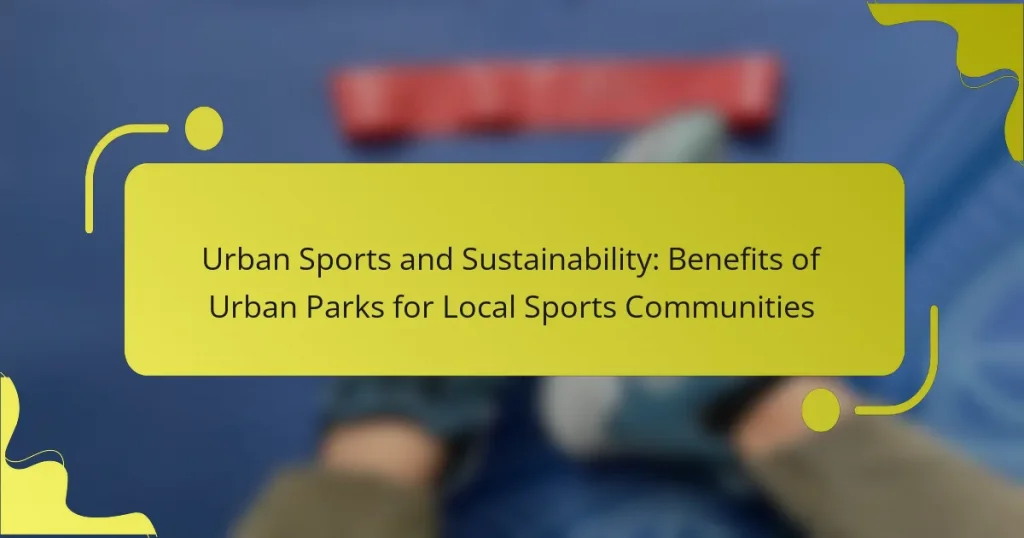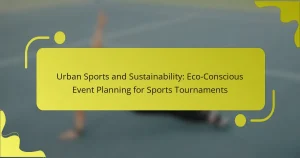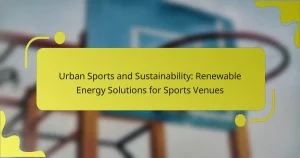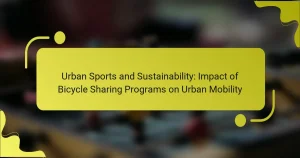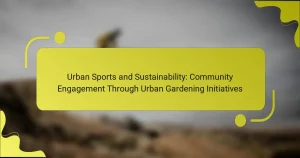Urban parks play a crucial role in enhancing local sports communities by providing accessible spaces for diverse athletic activities. They promote community engagement, support environmental sustainability, and foster physical health. These parks serve as venues for organized sports and casual play, while also addressing challenges such as limited space and accessibility. Innovative programs in urban parks are further strengthening community ties and promoting inclusivity in sports participation.
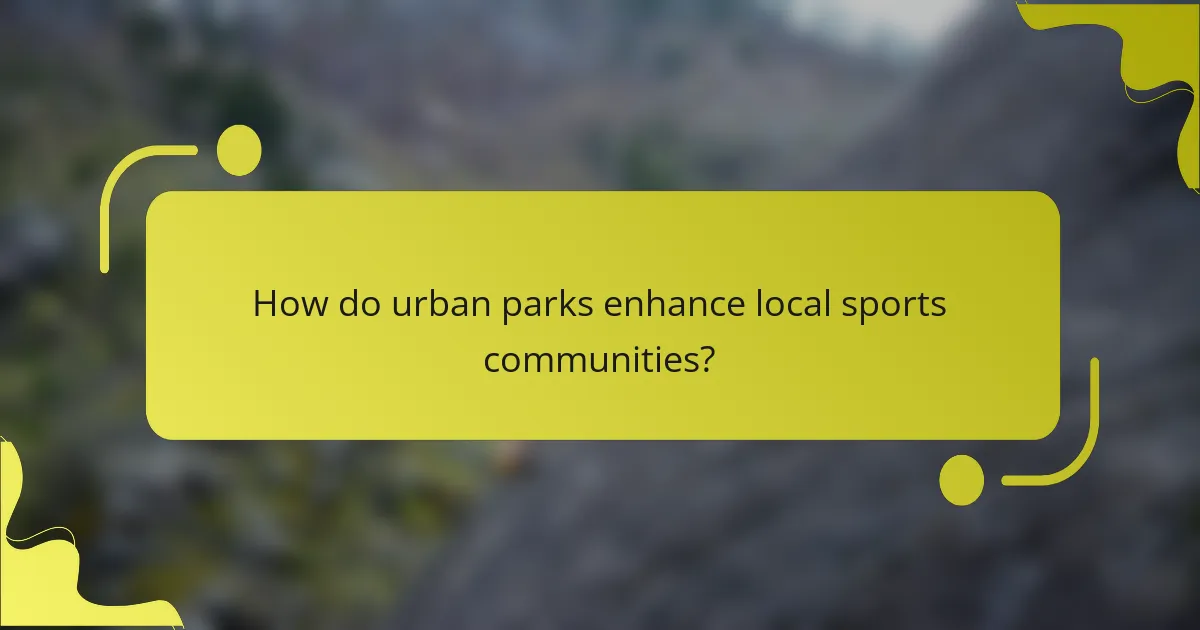
How do urban parks enhance local sports communities?
Urban parks significantly enhance local sports communities by providing accessible spaces for diverse athletic activities. They foster community engagement, promote physical health, and support environmental sustainability. Urban parks serve as venues for organized sports, casual play, and fitness events, creating opportunities for social interaction and teamwork.
Moreover, these parks often feature amenities such as sports fields, courts, and walking trails, which cater to various interests. The presence of green spaces contributes to improved mental well-being, encouraging more individuals to participate in sports. Local sports communities benefit from increased visibility and support when events are hosted in these parks, leading to greater community involvement and local pride.
As a result, urban parks become essential hubs for nurturing talent and promoting active lifestyles, ultimately strengthening the fabric of local sports communities.
What role do green spaces play in promoting physical activity?
Green spaces significantly enhance physical activity by providing accessible areas for exercise and recreation. Urban parks encourage community engagement and promote healthier lifestyles. Studies show that individuals living near parks are more likely to participate in regular physical activities, such as walking, jogging, and team sports. These spaces also foster social interactions, which can motivate individuals to stay active. Furthermore, parks often include facilities like sports fields and fitness stations, directly supporting various forms of exercise. The presence of green spaces can reduce stress and improve mental well-being, further promoting an active lifestyle.
How can urban parks facilitate community engagement in sports?
Urban parks facilitate community engagement in sports by providing accessible spaces for diverse activities. These parks encourage social interaction, foster teamwork, and promote physical health among residents.
Research indicates that urban parks can increase participation in sports by up to 25%. They serve as venues for organized events, informal games, and training sessions. Parks also offer facilities such as basketball courts, soccer fields, and running tracks, catering to various interests.
Moreover, green spaces enhance community identity and pride. They create opportunities for residents to connect, collaborate, and build lasting relationships through shared sports experiences. Engaging in sports within these parks contributes to overall community well-being and cohesion.
What are the social benefits of utilizing urban parks for sports?
Utilizing urban parks for sports fosters community engagement, promotes health, and enhances social cohesion. These parks provide accessible spaces for diverse groups to participate in physical activities, encouraging interactions among residents.
Urban parks support local sports events, which can strengthen community identity and pride. They often serve as venues for tournaments, fostering teamwork and collaboration among participants.
Moreover, green spaces contribute to mental well-being by offering a natural environment for relaxation and recreation. This aspect is crucial for reducing stress and improving overall quality of life for community members.
In addition, urban parks can promote inclusivity by accommodating various sports and activities, catering to different age groups and skill levels. This inclusivity enhances social bonds and encourages a sense of belonging within the local community.

Which sports thrive in urban park environments?
Urban parks support various sports, including basketball, soccer, running, and cycling. These environments foster community engagement and promote physical health. Urban parks provide accessible spaces for recreational activities, enhancing local sports culture. Additionally, they offer unique attributes like multipurpose fields and trails that cater to diverse athletic interests.
What are the most popular sports activities in urban parks?
Urban parks host a variety of popular sports activities that foster community engagement and promote sustainability. Key activities include basketball, soccer, running, cycling, and fitness classes. These activities enhance physical health and social interaction, making urban parks vital for local sports communities. Additionally, parks often provide accessible spaces for organized sports leagues and informal gatherings, reinforcing community ties.
How do urban parks accommodate diverse sports preferences?
Urban parks accommodate diverse sports preferences by offering versatile spaces for various activities. These parks provide facilities for team sports, individual workouts, and recreational activities, ensuring inclusivity. For example, basketball courts, soccer fields, and running trails coexist, catering to different interests. This variety promotes community engagement and encourages healthy lifestyles among residents. Additionally, parks often host events that introduce new sports, further enhancing their appeal.
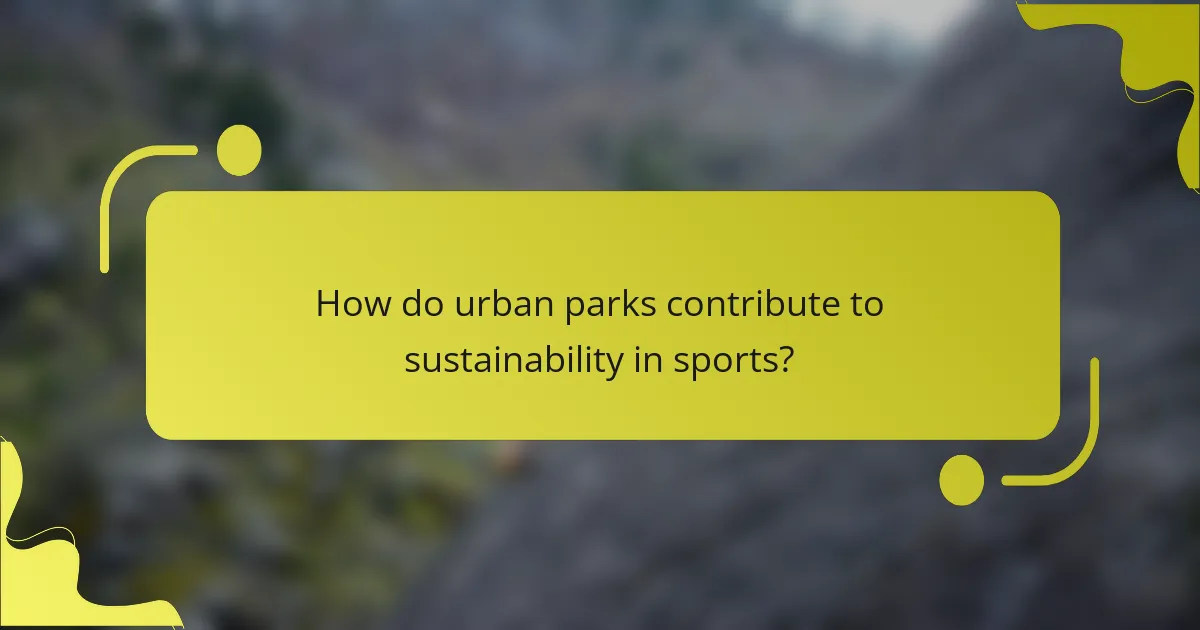
How do urban parks contribute to sustainability in sports?
Urban parks significantly enhance sustainability in sports by providing accessible green spaces for local communities. They promote physical activity, reduce urban heat, and support biodiversity. Parks serve as venues for various sports, fostering community engagement and encouraging healthier lifestyles. Their presence contributes to improved air quality and stormwater management, essential for sustainable urban environments. Additionally, parks can host events that raise awareness about environmental issues, further linking sports and sustainability.
What environmental benefits arise from sports activities in urban parks?
Sports activities in urban parks provide significant environmental benefits, including improved air quality, enhanced biodiversity, and increased green spaces. These parks serve as vital ecosystems that support various plant and animal species.
Engaging in sports helps promote community stewardship, encouraging residents to care for and maintain these natural areas. As a result, urban parks can mitigate urban heat, absorb rainwater, and reduce runoff.
Furthermore, the presence of sports facilities can lead to increased tree planting and habitat restoration efforts, contributing to overall urban sustainability. Enhanced recreational spaces also promote mental well-being, fostering a deeper connection between communities and their environment.
These factors collectively illustrate how urban sports activities can significantly contribute to environmental health and community resilience.
How can sustainable practices be integrated into urban park sports programs?
Integrating sustainable practices into urban park sports programs enhances community engagement and environmental health. Programs can implement eco-friendly materials for equipment, promote recycling initiatives, and utilize renewable energy sources for facilities. Collaborating with local environmental organizations can further support these efforts, fostering awareness and education on sustainability within sports communities. Additionally, incorporating native plant landscaping in park areas can improve biodiversity while providing natural spaces for athletes and spectators alike.
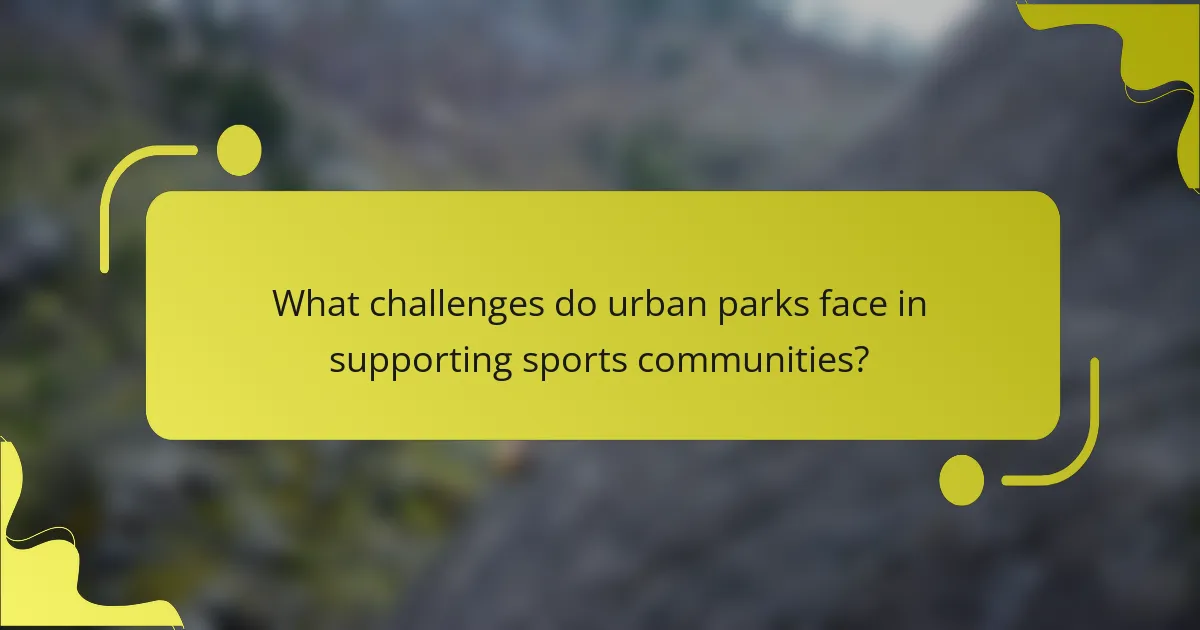
What challenges do urban parks face in supporting sports communities?
Urban parks face several challenges in supporting sports communities, including limited space, maintenance issues, and accessibility barriers. These factors can hinder the development of diverse sports programs and community engagement.
Limited space restricts the availability of facilities for various sports, making it difficult to accommodate growing interest. Maintenance issues can lead to unsafe conditions, discouraging participation. Accessibility barriers, such as inadequate transportation options, prevent some community members from utilizing park facilities.
Addressing these challenges requires collaboration between local governments, sports organizations, and community stakeholders to enhance infrastructure and promote inclusivity. This approach can foster a vibrant sports culture within urban parks, benefiting local communities.
How do maintenance and funding issues impact sports facilities in urban parks?
Maintenance and funding issues significantly hinder the functionality and accessibility of sports facilities in urban parks. Insufficient funding leads to deteriorating infrastructure, limiting opportunities for local sports communities. For example, poorly maintained fields can discourage participation and reduce safety. Urban parks rely heavily on community support and government investment to enhance facilities, impacting overall engagement in sports. As a result, addressing these challenges is crucial for sustaining vibrant local sports ecosystems.
What are common barriers to access for local sports communities in urban parks?
Common barriers to access for local sports communities in urban parks include inadequate facilities, lack of funding, limited transportation options, and insufficient programming. These obstacles hinder participation and limit the benefits urban parks can provide for sports communities. For instance, many parks may lack essential amenities like lighting or restrooms, which affects usability. Additionally, financial constraints can prevent organizations from offering diverse sports programs, impacting community engagement.
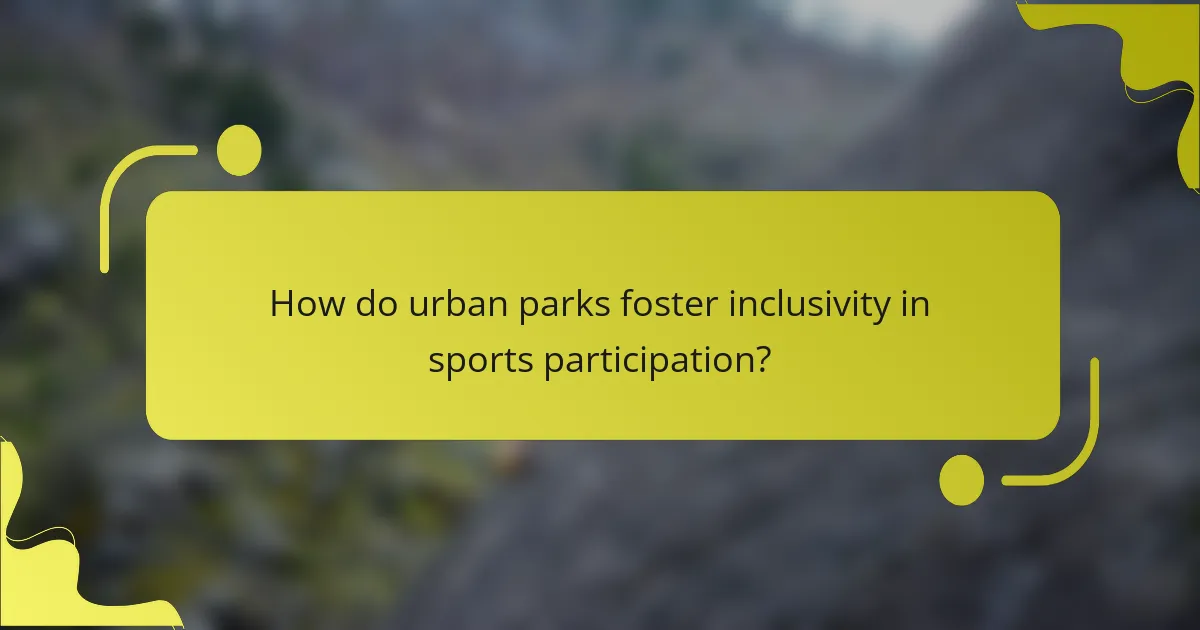
How do urban parks foster inclusivity in sports participation?
Urban parks significantly enhance inclusivity in sports participation by providing accessible spaces for diverse communities. They offer facilities and environments that accommodate various sports, encouraging participation among different age groups and skill levels.
These parks often host community events and programs, fostering social connections and breaking down barriers related to race, gender, and socioeconomic status. As a result, urban parks serve as vital hubs for promoting physical activity and social equity in local sports communities.
Research indicates that neighborhoods with well-maintained parks see higher rates of sports participation, highlighting the positive impact of these spaces on community health and cohesion. Urban parks are essential in creating inclusive environments that support diverse sporting activities.
What initiatives promote accessibility for all demographics in urban parks?
Urban parks promote accessibility through initiatives like inclusive design, community engagement, and adaptive sports programs. These efforts ensure facilities cater to diverse demographics, enhancing participation in local sports.
Examples include wheelchair-accessible paths, sensory-friendly spaces, and programs targeting underrepresented groups. These initiatives foster a sense of belonging and encourage a healthy lifestyle among all community members.
Additionally, partnerships with local organizations help identify needs and implement tailored solutions, further promoting inclusivity. Urban parks thus serve as vital hubs for community sports and engagement.
How can urban parks support underrepresented sports communities?
Urban parks can significantly enhance underrepresented sports communities by providing accessible spaces for diverse activities. They foster inclusivity and promote physical health, particularly in areas lacking resources. Parks often host community events, encouraging participation in sports that may not be traditionally recognized.
Additionally, urban parks can serve as venues for local leagues and tournaments, creating opportunities for visibility and engagement. By integrating features such as multi-sport courts and open fields, they cater to a variety of interests, helping to bridge gaps in participation across demographics.
Moreover, studies show that increased green space correlates with higher physical activity levels, particularly among marginalized groups. This connection underscores the role of urban parks in supporting not only recreational activities but also community cohesion and social interaction.
In summary, urban parks are vital in empowering underrepresented sports communities by providing essential resources, fostering inclusivity, and promoting health and well-being.
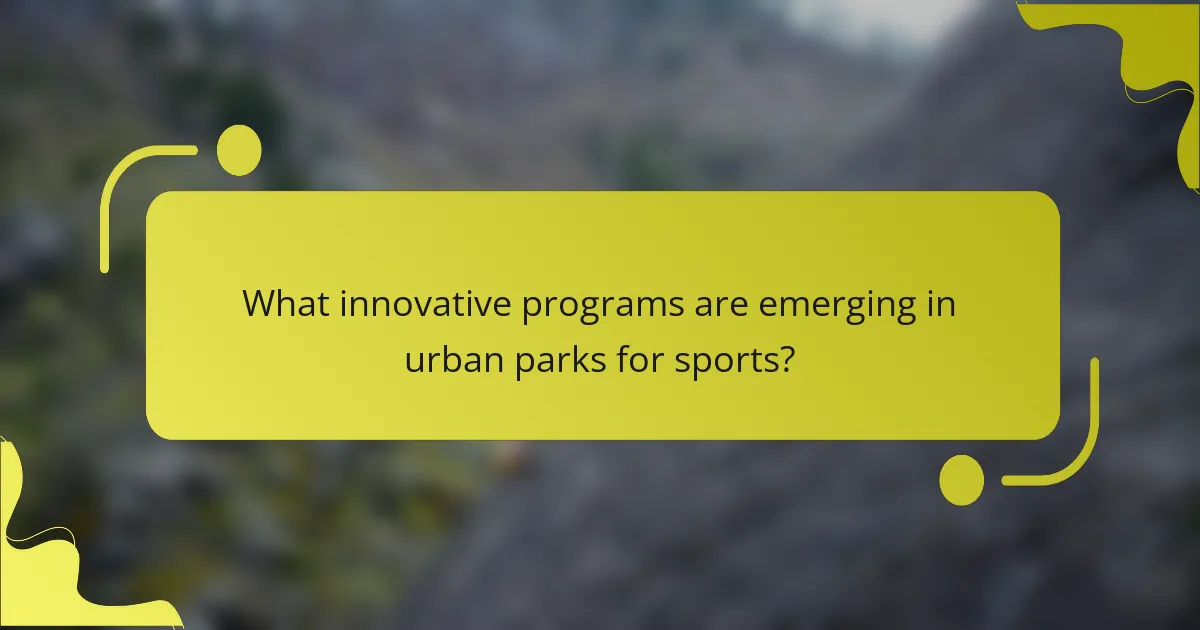
What innovative programs are emerging in urban parks for sports?
Innovative programs in urban parks are enhancing local sports communities through inclusive activities and sustainability initiatives. These programs focus on community engagement, offering diverse sports options like yoga, cycling, and fitness classes. They often incorporate eco-friendly practices, such as using recycled materials for equipment. Additionally, urban parks are becoming venues for organized sports leagues, fostering social connections among participants. Such initiatives not only promote physical health but also strengthen community ties, making urban parks vital for local sports development.
Which technology-driven solutions are enhancing sports experiences in urban parks?
Technology-driven solutions enhancing sports experiences in urban parks include smart lighting, app-based facility bookings, and augmented reality features. These innovations improve accessibility, engagement, and safety for local sports communities. Smart lighting extends playtime and enhances visibility, while app-based bookings streamline access to facilities. Augmented reality can provide interactive experiences, enriching the overall enjoyment of sports activities.
How are local organizations collaborating to improve urban park sports offerings?
Local organizations are collaborating to enhance urban park sports offerings by sharing resources and expertise. They establish partnerships that focus on community engagement and sustainability. For instance, local nonprofits often work with city governments to create inclusive sports programs. These initiatives promote physical activity and social cohesion among diverse populations. Additionally, organizations leverage grants and sponsorships to fund improvements in park facilities, ensuring they meet the needs of local sports communities. As a result, urban parks become vibrant hubs for recreational activities, fostering healthier lifestyles.

What best practices can enhance the use of urban parks for sports?
Utilizing urban parks for sports can be enhanced by implementing specific best practices. Engaging local communities fosters ownership and encourages participation. Regular maintenance ensures safe and accessible facilities. Offering diverse sports programs caters to various interests and skill levels. Collaborating with local organizations can provide resources and expertise. Creating inclusive environments promotes equity in access and participation.
How can community feedback shape urban park sports initiatives?
Community feedback can significantly enhance urban park sports initiatives by ensuring they meet local needs. Engaging residents fosters a sense of ownership and encourages participation. Feedback can guide the development of facilities, such as basketball courts or soccer fields, tailored to community preferences.
Additionally, incorporating input from diverse groups can promote inclusivity, ensuring that facilities cater to various age groups and skill levels. This alignment with community interests can lead to increased usage and better maintenance of the parks.
Moreover, community feedback can highlight unique attributes of local culture, allowing initiatives to reflect the area’s identity. As a result, urban parks can serve as vibrant hubs for local sports communities that thrive on collaboration and shared experiences.
What strategies promote sustainable sports events in urban parks?
Implementing eco-friendly practices, community engagement, and local partnerships promotes sustainable sports events in urban parks. These strategies enhance resource efficiency and foster a sense of ownership among local sports communities.
Utilizing renewable energy sources, such as solar panels for event lighting, reduces environmental impact. Additionally, encouraging waste reduction through recycling programs and composting helps maintain park cleanliness.
Engaging the community through volunteer opportunities strengthens bonds and increases participation in sustainable practices. Local partnerships with businesses can provide resources while promoting regional identity.
Finally, offering educational workshops on sustainability during events raises awareness and encourages ongoing commitment to eco-friendly practices.
